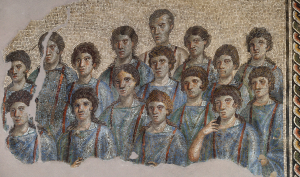Ancient Rome

| Part of the boylove history series |
 |
| Portal:History |
Unlike the Greeks, Romans never institutionalized pederasty.[1] Man-boy relationships were driven primarily by sexual desire, and there was no educating or civil pursuit involved. Furthermore, whereas the Greek erastes was charged with protecting the young eromenos, no such obligation existed in Rome.[2] Roman boylove, though influenced by the Greeks slaves brought to Rome, was often as violent and brutal as the Romans themselves. The Romans tended to value sexual conquest above romance and love. However, that is not to say that Roman men never fell in love with boys, which they did, and sometimes formed lifelong relationships. Pederasty came in and out of fashion during different periods of both the republic and the empire. Roman patricians frequently condemned the practice of Greek love publicly while privately complaining that "a pretty boy costs more than a plot of land …".[3] Many politicians and other affluent and influential Romans often kept young slave boys as lovers. Much romantic poetry written by older men to the boys who they loved or who's beauty they admired last to this day from around the time of Augustus.[4]
Elite Romans often kept a puer delicatus ("exquisite boy") as a form of high-status sexual consumption, a practice that continued well into the Imperial era. The puer delicatus was a slave chosen from the pages who served in a high-ranking household. He was selected for his good looks and grace to serve at his master's side, where he is often depicted in art. Among his duties, at a convivium (Roman drinking party equivalent of the Greek symposium) he would enact the role of Ganymede, the Trojan youth taken by Zeus to serve as a divine cupbearer.[5] Though the Romans viewed Greek love, or the cultural model of Greek pederasty, with a certain romanticism, and were mostly tolerant of the practice, it continued to be viewed as foreign and exotic or not quite the Roman way by the general public; Emperors such as Nero and Elagabalus, whose young male partners accompanied them in public for official ceremonies, were criticized for the perceived "Greekness" of their behavior.[6]
Roman law
Roman law, as described in the Lex Scantinia, mainly regulated the sexuality of freeborn men and boys. Romans considered men and boys who took the passive position in sexual intercourse as unmanly, thus the laws were written to protect the manhood of Roman citizens. Homosexuality and pederasty in Rome were acceptable and legal only within an inherently unequal relationship; male Roman citizens retained their masculinity as long as they took the active, penetrating role (or at least kept up the appearance of propriety), and the appropriate male sexual partner was a prostitute or slave, who would nearly always be non-Roman.[7] Only youths from freeborn families in good standing were covered under the law;[8] children born or sold into slavery, or those who fell into slavery through military conquest, were subject to prostitution or sexual use by their masters. Male prostitutes and entertainers, even if technically "free", were considered infames, of no social standing, and were also excluded from the protections afforded to the citizen's body. Although male slaves were sometimes granted freedom in recognition of a favored sexual relationship with their master, in cases of love and genuine affection the freed slaves may have remained legally slaves, since under the Lex Scantinia the couple could have been prosecuted if both were free citizens.[9] However, these laws were largely ignored by the Roman populace and tended to only be utilized as a political weapon. "The infrequency with which the Lex Scantinia is invoked in the literary sources suggests that prosecutions during the Republican era were mainly aimed at harassing political opponents".[10]
References
- ↑ Percy, William A. Pederasty and Pedagogy in Archaic Greece. University of Illinois Press, 1996. CHAPTER VI ISBN 0252067401
- ↑ http://www.thinkaboutit-knowaboutit.com/2013/03/an-objective-history-of-pederasty.html
- ↑ Polybius (31.25)
- ↑ http://www.matthewnederlanden.com/bible-commentary/jesus-heals-the-centurion-matthew-8.php
- ↑ Pollini, "Warren Cup," p. 34.
- ↑ Caroline Vout, Power and Eroticism in Imperial Rome (Cambridge University Press, 2007), p. 136ff.
- ↑ Helen King, "Sowing the Field: Greek and Roman Sexology," in Sexual Knowledge, Sexual Science: The History of Attitudes to Sexuality (Cambridge University Press, 1994), p. 30.
- ↑ Walters, "Invading the Roman Body," pp. 34–35; Richlin, The Garden of Priapus, p. 224.
- ↑ James L. Butrica, "Some Myths and Anomalies in the Study of Roman Sexuality," in Same-Sex Desire and Love in Greco-Roman Antiquity and in the Classical Tradition (Haworth Press, 2005), pp. 234–236.
- ↑ Butrica, "Some Myths and Anomalies in the Study of Roman Sexuality," p. 231; Ray Laurence, Roman Passions: A History of Pleasure in Imperial Rome (Continuum, 2009, 2010), p. 68.
